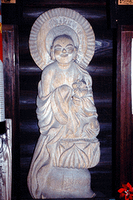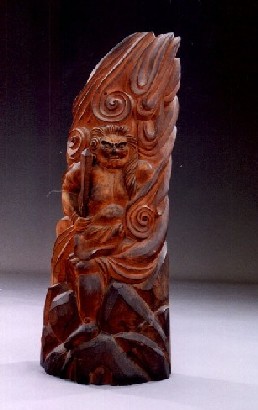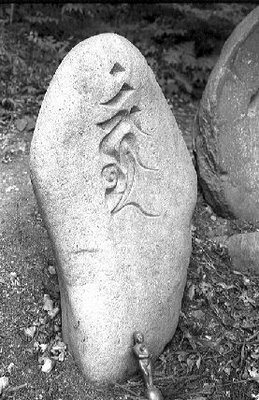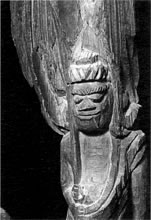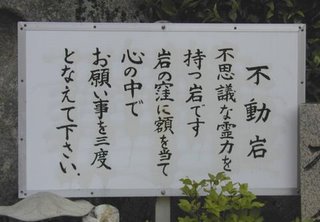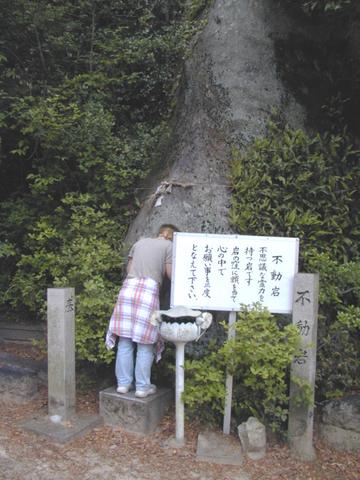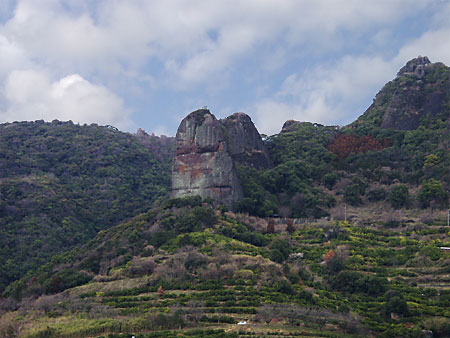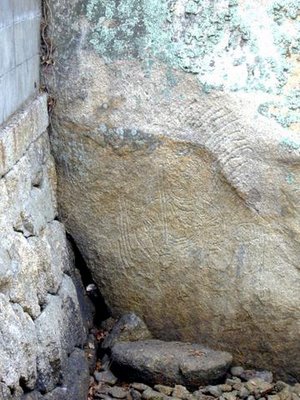[ . BACK to Daruma Museum TOP . ]
:::::::::::::::::::::::::::::::::::::::::::::::::::::::::::::::::::::::::::::::::::::::::::::::::::::::::::::::::::::::::::
Akakura Fudo 赤倉不動

Fudo Myoo ("the immutable one"), the Buddhist divinity of fire, is one of the most important beings venerated at
Akakura Mountain Shrine. He is known by his flaming sword and rope, with which he slashes away material connections and binds up evil-doers. His sword is used at Akakura in the Sword of Fudo healing ritual several times each year.
Fudo is the principal deity of the Five angry Lords of Light, venerated at Akakura in the Godaimyoo (Five Lords) hall. Fudo serves as tutelary deity to many of the shrine's kamisama spirit mediums. He has intimate associations with the dragon divinity and with the waterfall of Fudo, one of the most important sites of mountain ascetic discipline (shugyo). Several votive paintings at Akakura depict Fudo.
Akakura Fudo Waterfall 赤倉・不動滝
Akakura Mountain Shrine
- quote
The waterfall of Fudo, located within Akakura gorge, is located near the base of Akakura gorge. It is the most common destination of those undertaking shugyo (ascetic discipline) at Akakura Mountain Shrine. Here, worshippers pray intensely, reciting Hannya Shingyo and the
Fudo-son-ken-Kudoku-no-mon prayer to the fire divinity Fudo Myoo.

At the waterfall, ascetics may experience revelatory visions of Fudo or of the mountain's principal divinity
Akakura Daigongen in his various incarnations, including that of a dragon (a being intimately associated with water, rain and waterfalls.)
 Akakura Daigongen,
Akakura Daigongen, the principal divinity worshipped at Akakura Mountain Shrine, has multiple incarnations and forms.
He is at times seen as a young man, as a dragon (or pairs of dragons), as a beautiful woman, or even as a pair of trees or birds. His shotai (true form) is usually considered to be as a white-haired old man, as repesented in this shrine painting. -
On May 1st, when the gorge is still covered with snow and ice, the assembled shrine congregation collectively climbs to this spot and hangs a great
shimenawa (sacred rice straw rope) above the waterall, in the Mountain Opening Ceremony (Yamabiraki)
The waterfall is depicted in several votive paintings in the shrine, as in this image of the shrine foundress undertaking water discipline (mizu gyo) within its icy waters. As Carmen Blacker notes in The Catalpa Bow, the dedicated medium is believed to possess such great internal heat that she may experience the waterfall as a fire, intimately associated with Fudo Myoo's own flaming sword.

In this painting, the praying foundress, to the left of the waterfall, beholds a vision of vision of Akakura Daigongen (in his incarnation as a white haired old man) floating on a golden cloud.
Akakura Mountain Gorge, looms large in the iconography and ritual practice of the shrine. It is characterized by many dramatic volcanic and geological features, and is compared by many worshippers to a woman's genitalia, "the thing of a woman". Through it runs Akakura river, the source of the life-giving water of the gods. The gorge also spatially orients those undertaking mountain asceticism (shugyo).
source : Ellen Schattschneider : immortal wishes:
:::::::::::::::::::::::::::::::::::::::::::::::::::::::::::::::::::::::::::::::::::::::::::::::::::::::::::::::::::::::::::
- quote
Fudo Myoo Menuki
Fudo Myoo, the Buddhist divinity of fire, is one of the most important beings venerated at
Akakura Mountain Shrine.

He is known by his flaming sword and rope, with which he slashes away material connections and binds up evil-doers.
- source : www.kriscutlery.com
. Menuki 目抜き . sword fitting .
Menuki are pairs of small metal ornaments, secured one to each side of the hilt of the sword by means of a braid that covers the hilt.
:::::::::::::::::::::::::::::::::::::::::::::::::::::::::::::::::::::::::::::::::::::::::::::::::::::::::::::::::::::::::::
- trying to locate the mountain, since there are many with this name in Japan.
- reference -
Mt. Akakuradake 赤倉岳 (あかくらだけ)
- google search
 - Top of the Mountain
- Top of the Mountain
 photo by tenten mushi
photo by tenten mushi
:::::::::::::::::::::::::::::::::::::::::::::::::::::::::::::::::::::::::::::::::::::::::::::::::::::::::::::::::::::::::::
- In Aomori 青森
Akakurazawa 赤倉沢 at Mount Iwaki 岩木山
赤倉御殿 - 1433 meters
- source : www.yamareco.com
:::::::::::::::::::::::::::::::::::::::::::::::::::::::::::::::::::::::::::::::::::::::::::::::::::::::::::::::::::::::::::
There seem to be two mountains with this name in the
Hakoda Mountain range, Aomori:
- Northern Group:
Mount Akakuradake (赤倉岳 Akakura-dake) 1521 m
- Southern Group:
Mount Akakuradake (赤倉岳 Akakura-dake) 1290 m
The Hakkōda Mountains (八甲田山系 Hakkōda-sankei)
- - - More in the WIKIPEDIA !
:::::::::::::::::::::::::::::::::::::::::::::::::::::::::::::::::::::::::::::::::::::::::::::::::::::::::::::::::::::::::::
. 津軽弘法大師霊場 - Tsugaru Kobo Daishi Reijo
Pilgrimage to 23 Kobo Daishi temples in Tsugaru .
第二十一番札所 赤倉山 金剛寺(あかくらさん こんごうじ)
21 - 赤倉山 Akakurasan -
Kongooji 金剛寺 Kongo-Ji
平川市八幡崎宮本141
Miyamoto-141 Yawatasaki, Hirakawa-shi, Aomori
The main statue is
Monju Bosatsu 文殊菩薩.
Legend knows that an old man with white hair, riding a dragon, appeared in a dream and asked for a temple hall to be built here.
Kobo Daishi roamed this region in 820 陸奥国御巡錫 and also passed the
Akakura Reijo 赤倉霊場 Akakura Sacred Region.
He stood in front of a huge boulder and recited
「三世十方の諸仏、若しこの地に密教広まりなば、
此処に我が足跡を印し給え」
(All the sacred Buddhas, be my witness, let me promote the wisdom of Mikkyo Buddhism in this new land.
As a proof, show my footprint when I step on it.)
and as he stepped on the boulder, the footprint of his straw sandal became visible.
In 1960 the first 大師一代堂 Daishi Hall was erected in his honor, followed by the
大師堂 Daishi Do Hall in 1965.
In 1980 the main hall of temple 金剛寺 Kongo-Ji was built.

Every year at the 15th of June (now the third Sunday) for the beginning of the mountain climbing season a special fire ritual for the safety of the climbers are held
- yamabiraki 山開き
赤倉山霊場山開会 柴灯大護摩供執行
The uppermost temple in the compound, 金剛寺奥の院 Oku no In, there is a statue of Monju Bosatsu 文殊菩薩 as the personal protector of people born in the year of the rabbit.
ichidai mamori honzon 一代守り本尊 personal protector deity
- Chant of the temple
ながき夜の 夢さませとや 赤倉の暗きこころに光明さしくる
怠らず 願うこころの 赤倉や 赤き血潮に勇む老いの身
- Yearly Festivals
新2月25日
卯年生れ文殊菩薩/五穀豊就大菩薩/開運厄除星祭 初祭典
旧9月23日 - 山納 - End of the Climbing Season.
旧10月21日 - 大師講 四国八十八ヶ所お砂踏
O-sunafumi of the Shikoku 88 Henro temples
- seal of the temple, dedicated also to
Hotei 布袋, God of Good Luck.

- Homepage of the temple (with a map)
- source : kongoji.net
. Personal Protector / Ichidai Mamori Honzon .
.......................................................................
Mount Akakura, a region for Shugendo mountain ascetics,
lies at the "back side" of Mount Iwaki
赤倉は岩木山の裏の顔

赤倉大権現、または赤倉大神
神社の前には三十三観音や弘法大師像があった。
大石神社 Oishi Jinja and then
- 津軽赤倉山神社
Tsugaru Akakura Jinja
It has been built by 工藤むら Kudo Mura, who also made this statue of a Dragon-Fudo:

弘法大師や不動明王等も一緒に祭っている
Kobo Daishi and Fudo Myo-O are venerated here too.

Even further up the mountain is Akakura shrine

Beside it are more small sactuaries, dedicated to Jizo Bosatsu and others.
Along the road, another Kobo Daishi statue in white robes

next to a statue of "Yama no Kami", deity of the mountains.
弘法大師と山の神
And on top of the mountain, Akakura Shrine

with a three-storied pagoda.
Akakura Sacred Area 赤倉霊場
- source : www41.tok2.com/home/kanihei5
:::::::::::::::::::::::::::::::::::::::::::::::::::::::::::::::::::::::::::::::::::::::::::::::::::::::::::::::::::::::::::
[ . BACK to DARUMA MUSEUM TOP . ]
[ . BACK to WORLDKIGO . TOP . ]
:::::::::::::::::::::::::::::::::::::::::::::::::::::::::::::::::::::::::::::::::::::::::::::::::::::::::::::::::::::::::::








